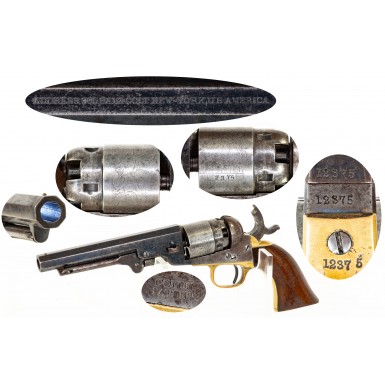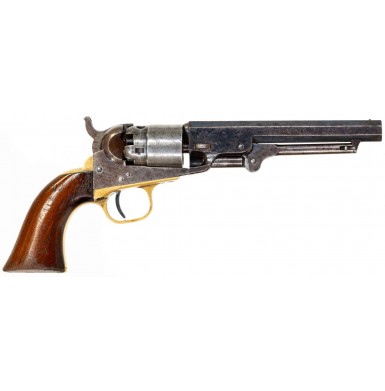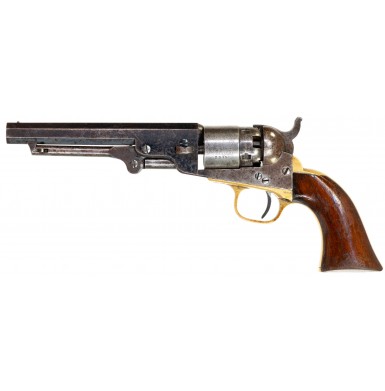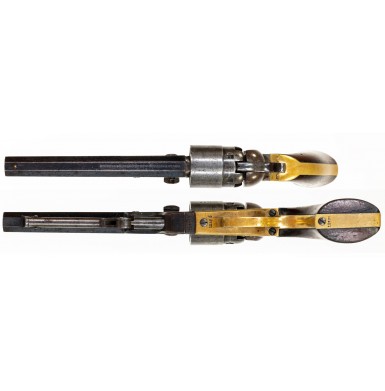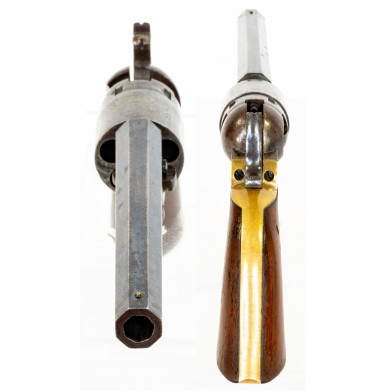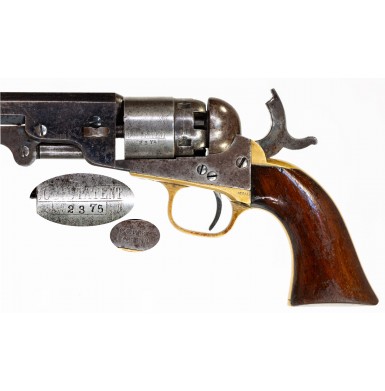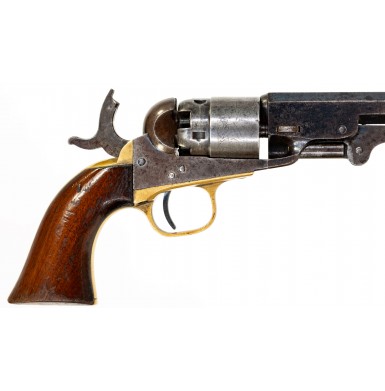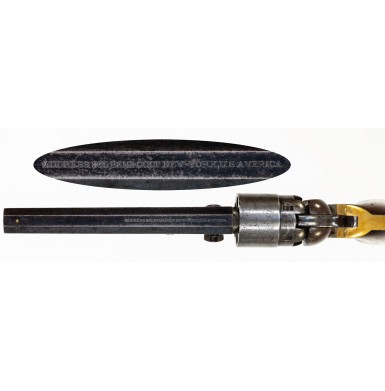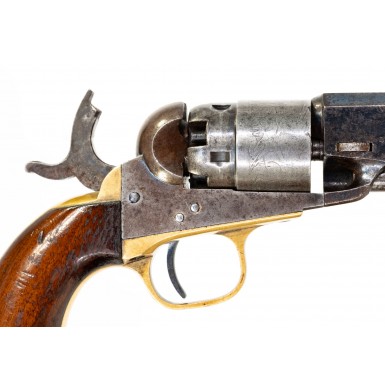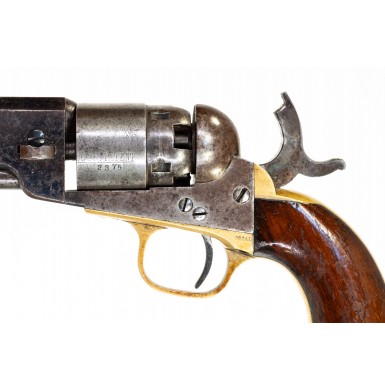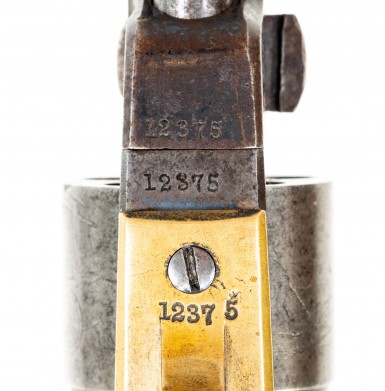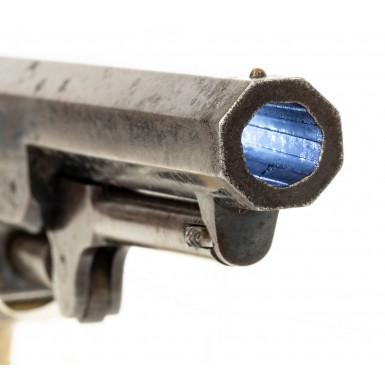Fine Colt Model 1862 Pocket Revolver of Navy Caliber
- Product Code: FHG-B140-SOLD
- Availability: Out Of Stock
-
$2,950.00
In 1861 Colt introduced two new pocket model revolvers in their more powerful .36 caliber chambering. Until that time, all of Colt’s “Pocket” guns had been .31 caliber, or in the case of some of the Root revolver production revolvers the even smaller .28 caliber. These new pocket revolvers can be considered “scaled up” 1849 Pocket Models or scaled down Belt Pistols (aka “Navy” models), as both guns had features drawn from their smaller and larger predecessors. The two new models were known as the Model 1862 Police and the Model 1862 Pocket Revolver of Navy Caliber. The “Police” model resembled a scaled down, early production Colt Model 1861 New Model Belt (Navy) Revolver, built on a Colt 1849 Pocket frame. The .36 caliber revolver had a five shot fluted cylinder and the grip frame and triggerguard were of Colt Pocket size and style. It had a round barrel, a creeping loading lever and was available in 3 ½”, 4 ½”, 5 ½” and 6 ½” barrel lengths. The Pocket Navy was essentially a scaled down Model 1851 Navy Revolver, again built on an 1849 Pocket frame, with a .36 caliber, five shot, rebated round cylinder that was roll engraved with the same Stagecoach Hold Up scene used on the 1849 Pocket Model. Like the Police model it used a Pocket-sized frame and triggerguard but had an octagonal barrel and conventional swinging link loading lever like those used on the Model 1849 and Model 1851 revolvers. Like the Police, it was available in four different barrel lengths, ranging from 3 ½” to 6 ½”, in 1” increments. The standard finish for both revolver models were blued barrels and cylinders, color casehardened frames and silver-plated brass backstraps, gripstraps and triggerguards. A few of the Police revolvers were produced with iron grip frames and triggerguards, which were also silver plated, but these are only found on very low number, early production revolvers. The earliest production revolvers will be found with the desirable Hartford barrel address, but the majority of the production carried the typical one-line New York barrel address. Although both models are referred to with the model date of 1862, both went into production during 1861, and would remain in production until the end of the Colt percussion era in 1873. During that time same a total of 47,000 of both models would be produced. The guns were manufactured concurrently and utilized the same serial number series, regardless of model, so the models are interspersed randomly within that serial number range. According to Colt researcher and author R.L Wilson, it is believed that about 60% of the total production of the two models was of the 1862 Police pattern, which would be approximately 28,200 guns, produced over the roughly thirteen year production period. Thus, the remaining 40% were of the Pocket Navy variety, or only about 18,800 of those guns produced over the same time frame. When compared to the superstars of the Colt percussion revolver product line, like the 1849 Pocket Model, this represented about an average single year of 1849 production! Colt manufactured approximately 331,000 1849 Pocket Models over roughly twenty-four years, averaging about 13,800 per year. This means that Colt manufactured more than seventeen Model 1849 Pocket Models for every 1862 Pocket Navy that was produced, or that the Colt 1862 Pocket Navy only represented about 6% of the production when compared to the venerable 1849 Pocket. For that reason, these guns are much less common on the collector market today than its smaller sibling is.
Offered here is a FINE condition Colt Model 1862 Pocket Revolver of Navy Caliber. The gun is a one of the 5 ½” octagonal barreled guns and is serial number 12375, placing its production in during 1862. The gun has matching numbers throughout on all parts, including the wedge, with the exception of the loading lever, which is not numbered. The unnumbered loading lever is common on this model of revolver. The gun has the standard rebated round cylinder with roll engraved Stagecoach Holdup scene. The top of the barrel is roll marked in a single line:
ADDRESS COL SAML COLT NEW-YORK U.S. AMERICA
The lower left side of the frame, forward of the cylinder is clearly stamped in two lines: COLT’S / PATENT. The left rear web of the triggerguard is marked 36 CAL. The cylinder has the usual boxed COLT’S PATENT marking over the boxed serial number marking No 2375. The revolver retains a large amount of its original finish, with about 75% of the original deep blue on the barrel. There are some minor dull traces of the case color in the protected areas of the frame, primarily behind the recoil shield. The barrel shows most of its finish loss as high edge wear along the sharp edges and contact points and around the muzzle in the form of holster wear. As usual, the barrel web shows some scattered impact marks around the wedge on both sides. There are also a few scattered impact marks on the barrel itself, mostly along the upper edges. The barrel is smooth and free of any real pitting but does show some moderate pinpricking on the flat of the muzzle and around the forcing cone, as well as some lightly scattered pinpricking here and there. There is also some scattered surface oxidation here and there, with oxidized flecks scattered throughout the remaining blue. The frame has faded to a mostly dull smoky gray patina with some scattered areas of soft darker mottling from the case coloring and some very minor traces color in the protected areas. The frame is also free of any real pitting but does show some flecks of surface oxidation and some very minor flecks of pinpricking. The cylinder retains some traces of its original blue, most of which is in the protected rebated portion of the cylinder at its rear. The cylinder retains the large majority of its roll engraved scene, rating at least 80%+. The periphery of the cylinder is free of any significant pitting, but both the cone (nipple) recesses at the rear of the cylinder and the face of the cylinder show moderate amounts of oxidation and erosion from cap flash and hot gasses, as well as some light pinpricking. The hammer retains some traces of dull and faded case coloring. The loading lever retains some strong traces of vivid case color on the web with the majority of the lever having a dull, silvery gray patina. Although the lever is unnumbered its patina and wear match the balance of the gun so perfectly there is no indication that the lever is a replacement and has clearly been with the pistol for its entire life. The brass gripstrap, backstrap and triggerguard retain none of their silver-plated finish and have a rich, uncleaned and untouched ochre patina. The bore of the revolver is in about FINE condition as well and is mostly bright with crisp rifling and showing only some lightly scattered pitting along its length, mostly in the grooves. The original truncated brass cone front sight is in place on the top of the barrel, near the muzzle. All of the cones (nipples) appear to be original and remain in place at the rear of the cylinder. They show light to moderate wear but remain fairly crisp and quite usable. The remnants of the original safety pins remain in place on the rear of the cylinder, and survive in varying levels of completeness. The screws all remain fairly sharp and crisp, and most retain at some least traces of their original faded fire-blued finish. Only a couple of the screws show more than some light slot wear. The revolver is in mechanically FINE condition and times, indexes and locks up perfectly. The action remains crisp and tight, and the revolver operates exactly as it should. The one-piece walnut grip is in about FINE condition as well, and remains solid and free of any breaks, cracks, or repairs. The grip retains much of its original varnish but does show moderate wear and areas of finish loss. There is wear and some minor rounding to the lower flared edges of the grips. This is also the area that shows the most wear and loss to the varnish. The grip also shows a moderate amount of scattered wear, including bumps, dings, surface mars and some rubs and scuffs.
Overall, this is very attractive and desirable example of a scarce Colt 1862 Pocket Model of Navy Caliber. These are relatively scarce guns with very limited production when compared to the 1849 Pocket and the 1851 Navy revolvers. This is a relatively high condition gun that displays very well and would be a fine addition to any collection of Colt percussion revolvers or Civil War era handguns.
Tags: Fine, Colt, Model, 1862, Pocket, Revolver, of, Navy, Caliber

